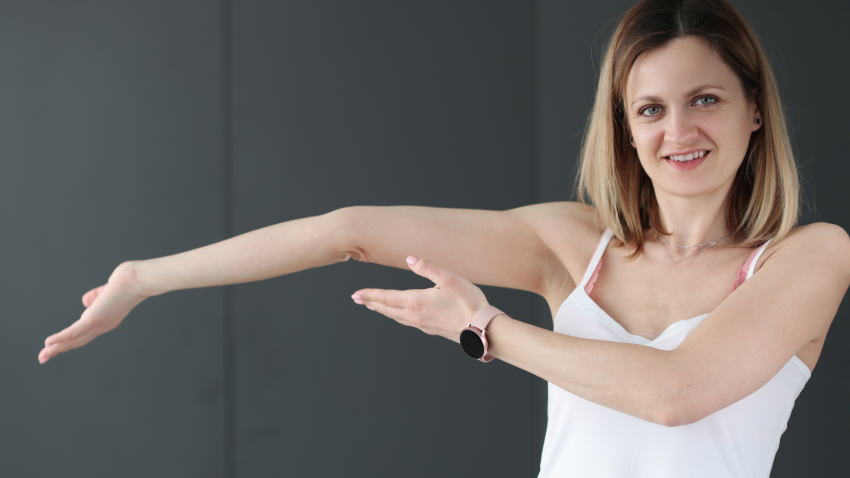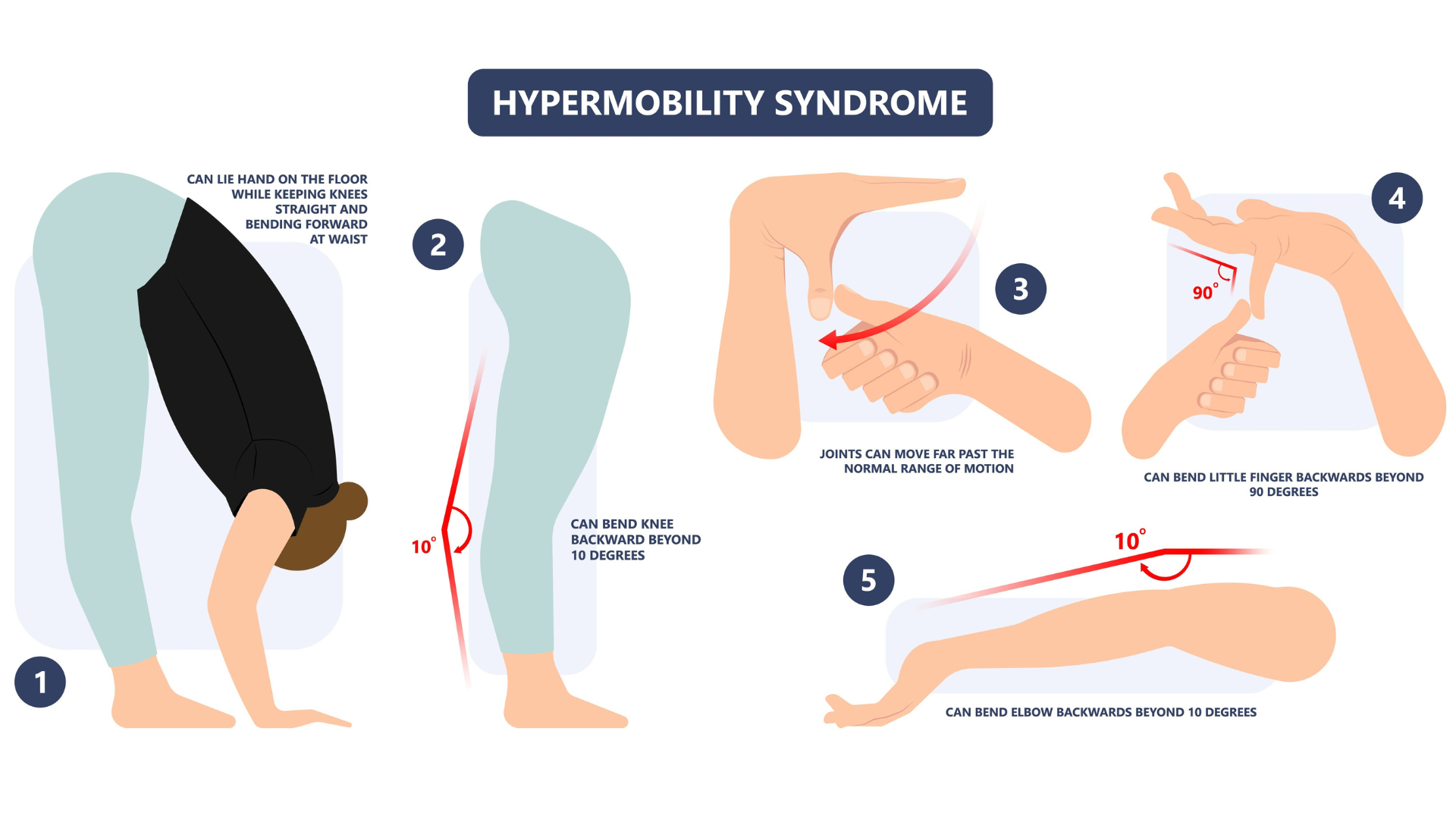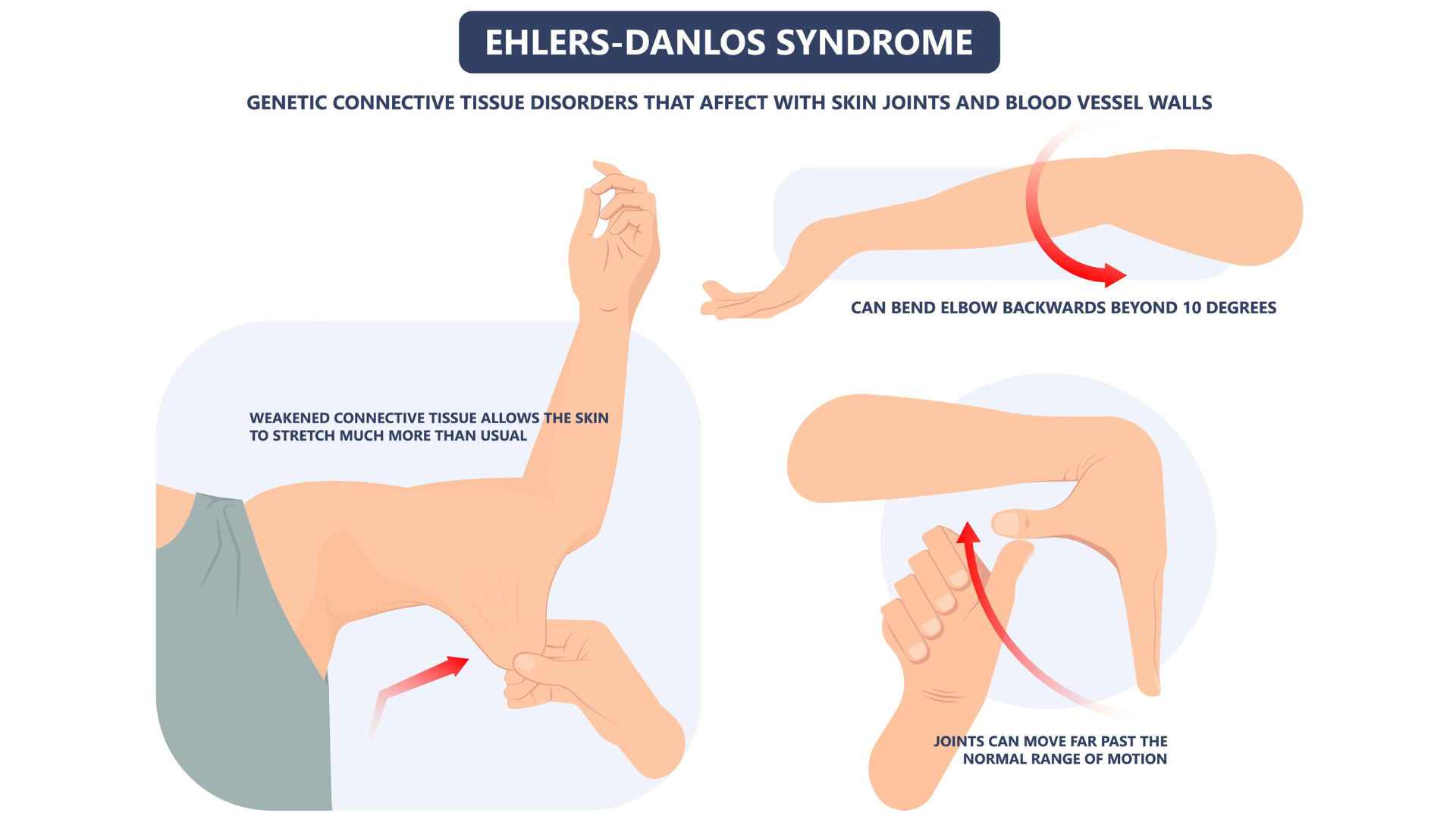View basket (0 items $0.00)

Do You Have Joint Hypermobility?
Generalized joint laxity (loose joints throughout the body) is fairly common in between 20 percent and 30 percent of the population. This joint hypermobility can occur without a systemic disease that affects connective tissues, like Ehlers-Danlos syndrome or Marfan syndrome.
While joint hypermobility is often labeled “benign,” it can lead to and be associated with many health issues. If you suspect that you have joint hypermobility and are experiencing any symptoms like joint pain, dislocations, spinal issues, muscle tightness and spasms, thin or stretchy skin, bruising, fatigue, or dizziness, you should consult your doctor. And it’s important to know that a broad range of conditions—like anxiety, fibromyalgia, chronic fatigue syndrome, and digestive issues—can occur along with joint hypermobility. This often leads to misdiagnosis, so it’s important to research and be your health advocate.
How Do You Know If You Have Joint Hypermobility?
When you first visit your doctor to determine whether or not you have a condition that causes joint hypermobility, they may start by asking you the following questions:
-
Can you now, or could you ever, place your hands flat on the floor without bending your knees?
-
Can you now, or could you ever, bend your thumb to touch your forearm?
-
As a child, did you amuse your friends by contorting your body into strange shapes, or could you do the splits?
-
As a child or teenager, did your shoulder or kneecap dislocate on more than one occasion?
-
Do you consider yourself double-jointed?
If your answers to these questions indicate that you might have joint hypermobility, the next step will be to assess your Beighton score. (Note: the Brighton criteria are used to determine your Beighton score; don’t be confused by the similar spelling!)
Your Beighton score will be between 0 and 9 depending on your ability to do the following things:
-
Bend your pinky finger backward at the knuckle beyond 90 degrees
-
Flex your wrist forward and push your thumb back to touch your forearm
-
Extend your elbow more than 10 degrees beyond a normal straight position
-
Extend your knees more than 10 degrees beyond a normal straight position
-
Bend forward and place the palms of your hands flat on the floor without bending your knees
Typically, a Beighton score of 4 or more indicates generalized joint laxity. If your Beighton score is 4 or more and you are experiencing any noticeable health issues, read on.
Benign Joint Hypermobility Syndrome
Benign joint hypermobility syndrome (BJHS) is the presence of musculoskeletal complaints in hypermobile individuals with no systemic rheumatologic disease. Benign joint hypermobility syndrome is thought to result from an abnormality in collagen, and mutations in the fibrillin gene have also been identified. The syndrome is often inherited, as first-degree relatives with the disorder can be identified in around 50 percent of cases.
The most common symptoms felt in people with benign joint hypermobility syndrome are joint hypermobility and joint pain (arthralgia). When joints are excessively loose, it can cause abnormal wear and tear on joint surfaces, leading to pain and degeneration of joints over time. Some research suggests that joint proprioception (internal sense of joint position and movement) in people with benign joint hypermobility syndrome can be impaired, and insufficient or incorrect sensory feedback can lead to dysfunctional movement patterns, poor posture, and pain.
When joints are very loose, people must rely on their muscles for stability in posture and movement. So, it is common for people with joint hypermobility to develop chronic muscular tension and to experience muscle spasms.
Ehlers-Danlos Syndrome
Ehlers-Danlos syndrome (EDS) is a group of connective tissue disorders that can be inherited. Ehlers-Danlos syndrome is currently classified into 13 different subtypes. The most common symptoms of
Ehlers-Danlos syndrome includes hypermobile joints, thin or hyperelastic (abnormally stretchy) skin, and skin that bruises or scars easily.
Benign hypermobility joint syndrome is thought to be a mild version of hypermobile Ehlers-Danlos syndrome (hEDS); some researchers suggest that benign joint hypermobility syndrome is on a continuum with hypermobile Ehlers-Danlos syndrome.
Since Ehlers-Danlos syndrome is a problem with the structure of connective tissue, various symptoms can occur throughout the body—from skin, muscles, tendons, and ligaments to blood vessels, organs, gums, and eyes. And while joint hypermobility can lead to increased muscle tension because of the need for stability, some types of Ehlers-Danlos syndrome involve muscle hypotonia (abnormally loose muscles). Ehlers-Danlos syndrome can cause serious, even life-threatening health conditions, including cardiovascular problems, organ rupture, and prolapse.
Conditions Associated with Ehlers-Danlos and Joint Hypermobility Syndromes
Both benign joint hypermobility syndrome and hypermobile Ehlers-Danlos syndrome are associated with a broad range of stress-related, psychological, behavioral, neurological, somatic, and gastrointestinal conditions, which you can see in the tables below. The occurrence of these conditions, along with benign joint hypermobility syndrome and hypermobile Ehlers-Danlos syndrome, may be caused by many different factors, including altered body perception, structural differences in emotion processing regions of the brain, and autonomic nervous system dysfunction.
When any of the conditions below are present, patients may be misdiagnosed, or their underlying joint hypermobility may go undetected. Due to the broad range of symptoms and conditions related to joint hypermobility, some patients may be seen as being hypochondriacs. As always, it is important to be your own health advocate.
What Are Some Other Conditions That Cause Joint Hypermobility?
-
Joint hypermobility can be present in other conditions, including but not limited to:
-
Marfan syndrome: a connective tissue disorder resulting from a mutation in FBN1, one of the genes that makes fibrillin
-
Osteogenesis imperfecta: a group of genetic disorders that mainly affect the bones
-
Down syndrome: a genetic disorder typically associated with a characteristic facial appearance, developmental and cognitive delays
-
Homocystinuria: an inherited disorder in which the body is unable to process certain building blocks of proteins properly
-
Hyperlysinemia: an inherited condition caused by a shortage of the enzyme that breaks down lysine, a building block of most proteins.

4 Ways to Treat Benign Joint Hypermobility Syndrome
Since benign joint hypermobility syndrome is nonprogressive and noninflammatory, treatment is generally supportive in nature. People with benign joint hypermobility syndrome can often effectively manage their condition by modifying their activities, protecting their joints, reducing excess muscle tension, and learning how to improve their body mechanics.
1. Modify Activities
Overtraining and excessive joint movement are known to induce symptoms like joint pain in people with benign joint hypermobility syndrome. People with benign joint hypermobility syndrome should notice what activities increase symptoms and reduce or avoid them. Types of exercise that involve intense stretching should be avoided, and workouts should focus on increasing strength and stability.
2. Protect the Joints
People with benign joint hypermobility syndrome are advised not to sit cross-legged with their knees bent and to stop doing unusual joint movements to entertain their friends. They should also stand with their knees slightly bent if they have a tendency to hyperextend their knees. Bracing, splinting, or taping can provide beneficial joint support.
3. Reduce Excess Muscle Tension While Not Stretching Connective Tissues
People with joint hypermobility can develop chronic muscle tension and experience muscle spasms because their muscles have to work extra hard to stabilize their joints. So while it is important to avoid building up excess muscle tension, it is also critical for people with benign joint hypermobility syndrome to avoid static stretching, which stretches tendons and ligaments. Clinical Somatics exercises are an ideal and highly effective way for people with benign joint hypermobility syndrome to release tight muscles (using the movement technique of pandiculation) without stretching their connective tissues.
4. Improve body mechanics: Exercises that focus on proprioception (internal sense of body position) allow people with benign joint hypermobility syndrome to retrain their posture and movement and improve their ability to instinctively avoid positions and movements that could be painful or damaging. The slow, conscious nature of all Clinical Somatics exercises, along with the specific proprioceptive exercises that are taught, make Clinical Somatics an ideal therapeutic modality for people with benign joint hypermobility syndrome.
Reprinted with permission from Somatic Movement Center.
 Sarah Warren St. Pierre is a Certified Clinical Somatic Educator and the author of the book The Pain Relief Secret. She was trained and certified at Somatic Systems Institute in Northampton, MA. Sarah has helped people with chronic muscle, and joint pain, sciatica, scoliosis, and other musculoskeletal conditions become pain-free by practicing Thomas Hanna’s groundbreaking method of Clinical Somatic Education. Sarah is passionate about empowering people to relieve their pain, improve their posture and movement, and prevent recurring injuries and physical degeneration.
Sarah Warren St. Pierre is a Certified Clinical Somatic Educator and the author of the book The Pain Relief Secret. She was trained and certified at Somatic Systems Institute in Northampton, MA. Sarah has helped people with chronic muscle, and joint pain, sciatica, scoliosis, and other musculoskeletal conditions become pain-free by practicing Thomas Hanna’s groundbreaking method of Clinical Somatic Education. Sarah is passionate about empowering people to relieve their pain, improve their posture and movement, and prevent recurring injuries and physical degeneration.
Resources:
1. Bernhoff, G., Huhmar, H., & Käll, L. B. (2021). Assessment of systemic joint laxity in the clinical context: Relevance and replicability of the Beighton score in chronic fatigue. Journal of Back and Musculoskeletal Rehabilitation, 35(4), 859-866. https://doi.org/10.3233/BMR-210081
Featured Courses









